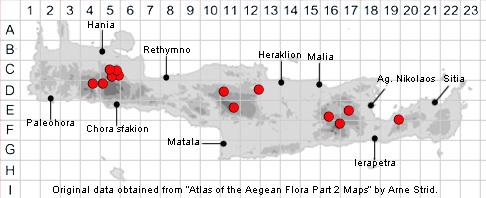SPECIES DESCRIPTION
COTONEASTER CRETICUS
Family and Genus:- See- ROSACEAE
Common Names:- None
Homotypic Synonyms:- Cotoneaster nummularius
Meaning:- Cotoneaster (L) Wild-quince
Creticus (L) From Crete, Cretan.
General description:- Erect, deciduous shrub
Stems:-
1) Up to 1·5 m, but sometimes dwarfed by exposure; young twigs grey-tomentose.
Leaves:-
1) 1-2·5 x 0·9-2·2 cm, broadly elliptical, obovate, or suborbicular, obtuse,
mucronate, sometimes emarginate, sparsely hairy above when young, densely
tomentose, beneath.
2) Petiole, 1·5-2·5 mm, tomentose.
Flowers:-
1) Inflorescence, 3- to 7-flowered, dense.
2) Hypanthium and calyx tomentose.
Fruit:-
1) c. 8 mm, subglobose, red, whitish-pubescent when young, becoming glabrous.
2) Pyrenes, 2.
Key features:-
1) Leaves, persistently tomentose beneath.
2) Inflorescence, dense.
3) Hypanthium and sepals tomentose.
Habitat:- Crevices and ledges of limestone cliffs, gorges, screes, thorncushion
communities in dolines. (400-)900-1900 m.
Distribution:- Cretan endemic from the four main massifs where it is sparse and
very rare.
Flowering time:- Mid-May to early June.
Photos by:- Courtesy of Wiki-Commons

